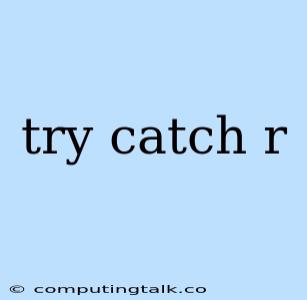The Power of try...catch in Programming: A Guide to Handling Errors Gracefully
The try...catch block is a fundamental concept in many programming languages. It's like a safety net, enabling your code to gracefully handle unexpected situations and prevent abrupt crashes. Understanding try...catch empowers you to build robust applications that can withstand various errors, leading to a smoother user experience.
What is a try...catch Block?
Imagine your code is like a journey. Sometimes, unexpected obstacles might pop up, like a missing file, a network connection issue, or a faulty input from the user. If you don't have a safety net, your code might abruptly crash, leaving the user in a state of confusion and frustration. This is where the try...catch block comes to the rescue.
The try...catch block in programming allows you to anticipate potential errors and handle them gracefully. It works like this:
tryBlock: You place the code you suspect might throw an error within thetryblock.catchBlock: If an error occurs within thetryblock, the program jumps to thecatchblock. Thecatchblock catches the error and provides a way to handle it.
Why is try...catch Important?
1. Preventing Program Crashes: By catching errors, try...catch prevents your program from abruptly terminating, ensuring a smoother user experience.
2. Providing Feedback: Instead of a cryptic error message, try...catch allows you to display a user-friendly message explaining what went wrong.
3. Handling Errors Gracefully: try...catch helps you handle errors in a controlled manner, enabling you to take corrective actions or attempt alternative solutions.
4. Debugging Made Easier: try...catch allows you to pin down the specific error that caused the problem, making it easier to identify and fix issues during development.
How to Use try...catch
Let's look at a simple example in JavaScript:
function divideNumbers(a, b) {
try {
let result = a / b;
console.log("The result of the division is:", result);
} catch (error) {
console.error("Error:", error);
console.log("Division by zero is not allowed!");
}
}
divideNumbers(10, 0); // This will trigger the catch block
In this example:
- We define a function
divideNumbersthat attempts to divide two numbers. - The division operation (
a / b) is placed within thetryblock. - If
bis 0, dividing by zero will cause an error, and thecatchblock will execute. - The
catchblock displays an error message and a helpful message for the user.
Beyond Basic Error Handling
try...catch offers more than just basic error handling. Here are some advanced techniques:
1. Specific Error Handling: You can catch specific error types using the catch block's parameter:
try {
// ...code that might throw an error...
} catch (TypeError) {
// Handle TypeError specifically
} catch (ReferenceError) {
// Handle ReferenceError specifically
} catch (error) {
// Handle other errors
}
2. Re-throwing Errors: In some cases, you might want to re-throw an error after handling it partially:
try {
// ...code that might throw an error...
} catch (error) {
// Perform some error logging or other processing...
throw error; // Re-throw the error
}
3. Finally Block: The finally block is executed regardless of whether an error occurred or not. This is useful for cleaning up resources, like closing files:
try {
// ...code that might throw an error...
} catch (error) {
// Handle the error...
} finally {
// Close the file, regardless of whether an error occurred
}
Best Practices for Using try...catch
- Avoid Catching Too Broadly: Avoid catching generic
Errortypes unless necessary. Be specific about the errors you anticipate. - Don't Use
try...catchfor Validation:try...catchis not intended for general input validation. Use validation checks before attempting operations that might cause errors. - Log Errors: Always log errors to help you track down problems during development and production.
- Keep
try...catchBlocks Focused: Keep the code withintry...catchblocks as concise as possible.
Conclusion
The try...catch block is an indispensable tool for building robust and reliable software applications. By embracing try...catch, you can empower your code to handle unexpected situations gracefully, ensuring a more pleasant user experience and simplifying the debugging process. By following best practices, you can harness the power of try...catch to write more robust, resilient, and error-resistant programs.
